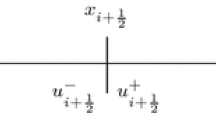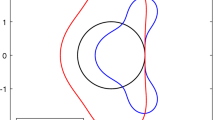Abstract
We present adaptive finite difference ENO/WENO methods with infinitely smooth radial basis functions (RBFs). These methods slightly perturb the polynomial reconstruction coefficients with RBFs as the reconstruction basis and enhance accuracy in the smooth region by locally optimizing the shape parameters. Compared to the classical ENO/WENO methods, the RBF-ENO/WENO methods provide more accurate reconstructions and sharper solution profiles near the jump discontinuity. Furthermore the RBF-ENO/WENO methods are easy to implement in the existing classical ENO/WENO code. The numerical results in 1D and 2D presented in this paper show that the proposed finite difference RBF-ENO/WENO methods perform better than the classical ENO/WENO methods.








Similar content being viewed by others
Notes
The value of \(\varepsilon ^2\) is not necessarily non-negative and \(\varepsilon \) can be either real or complex for the optimization of the error. We note that the raw value of the shape parameter, \(\varepsilon \), is not used for the reconstruction; what we use in the reconstruction is \(\varepsilon ^2\). Thus a complex value of \(\varepsilon \) is still allowed for the RBF-ENO/WENO formulation.
To prevent the case that the denominator of (24) becomes zero, a small positive number \(\gamma \), is added in the denominator. In practice, we use \(\varepsilon ^2 \approx \frac{2}{\varDelta x^2}\cdot \frac{-f_{i-1}+2f_{i}-f_{i+1}}{-f_{i-1}+5f_{i}+2 f_{i+1}+\gamma }\), where \(\gamma \) is a small positive constant, e.g. \(\gamma = 10^{-13}\).
Note that the denominator in (26) could be zero. However, in the implementation of the RBF-ENO/WENO methods, we apply a modified version of (27), which is explained in [8, 9]. In this alternative way of implementation, we check the magnitude of the denominator first. Only when the denominator is larger than some threshold, we compute the critical point as in (26) to check whether it is within the interval of [0, 3]. Otherwise, the stencil is considered to be smooth.
The precise CFL condition is \(\varDelta t = C {\varDelta x}^{{\ell }/{3}}\), where \(\ell \) is the order of the method. Since we are using a simpler form of \(\varDelta t = C \varDelta x\), the convergence is slower than expected for the small values of N. But for the large values of N, we can use the linear relation between the temporal and spatial spacings. This is what we observe in Tables 4 and 5, as well as in Figs. 1 and 3.
References
Aboiyar, T., Georgoulis, E.H., Iske, A.: Adaptive ADER methods using kernel-based polyharmonic spline WENO reconstruction. SIAM J. Sci. Comput. 32, 3251–3277 (2010)
Borges, R., Carmona, M., Costa, B., Don, W.-S.: An improved WENO scheme for hyperbolic conservation laws. J. Comput. Phys. 227, 3191–3211 (2008)
Buhman, M.D.: Radial Basis Functions—Theory and Implementations. Cambridge University Press, Cambridge (2003)
Chen, X., Jung, J.-H.: Matrix stability of multiquadric radial basis function methods for hyperbolic equations with uniform centers. J. Sci Comput. 51, 683–702 (2012)
Costa, B., Don, W.-S.: High order hybrid central—WENO finite difference scheme for conservation laws. J. Comput. Appl. Math. 204, 209–218 (2007)
Costa, B., Don, W.-S.: Multi-domain hybrid spectral-WENO methods for hyperbolic conservation laws. J. Comput. Phys. 224, 970–991 (2007)
Costa, B., Don, W.-S., Gottlieb, D., Sendersky, R.: Two-dimensional multi-domain hybrid spectral-WENO methods for the conservation laws. Commun. Comput. Phys. 1, 1–31 (2006)
Guo, J., Jung, J.-H.: A RBF-WENO finite volume method for hyperbolic conservation laws with the monotone polynomial interpolation method. Under review (2016)
Guo, J., Jung, J.-H.: A numerical study of the local monotone polynomial edge detection for the hybrid WENO method. Under review (2016)
Ha, Y., Kim, C.H., Lee, Y.J., Yoon, J.: An improved weighted essentially non-oscillatory scheme with a new smoothness indicator. J. Comput. Phys. 232, 68–86 (2013)
Harten, A., Engquist, B., Osher, S., Chakravarthy, S.R.: Uniformly high order accurate essentially non-oscillatory schemes III. J. Comput. Phys. 71, 231–303 (1987)
Henrick, A.K., Aslam, T.D., Powers, J.M.: Mapped weighted-essentially non-oscillatory schemes: achieving optimal order near critical points. J. Comput. Phys. 207, 542–567 (2005)
Hesthaven, J., Gottlieb, S., Gottlieb, D.: Spectral Methods for Time Dependent Problems. Cambridge University Press, Cambridge (2007)
Jiang, G.-S., Shu, C.-W.: Efficient implementation of weighted ENO schemes. J. Comput. Phys. 126, 202–228 (1996)
Larsson, E., Fornberg, B.: Theoretical and computational aspects of multivariate interpolation with increasingly flat radial basis functions. Comput. Math. Appl. 49, 103–130 (2005)
Lax, P.D.: Weak solutions of nonlinear hyperbolic equations and their numerical computation. Commun. Pure Appl. Math. 7, 159–193 (1954)
Lee, Y., Yoon, J., Micchelli, C.: On convergence of flat multivariate interpolation by translation kernels with finite smoothness. Constr. Approx. 40, 37–60 (2014)
Li, P., Gao, Z., Don, W.-S., Xie, S.: Hybrid Fourier-continuation method and weighted essentially non-oscillatory finite difference scheme for Hyperbolic Conservation Laws in a single-domain framework. J. Sci. Comput. 64, 670–695 (2015)
Shahbazi, K., Albin, N., Bruno, O.P., Hesthaven, J.S.: Multi-domain Fourier-continuation/WENO hybrid solver for conservation laws. J. Comput. Phys. 230, 8779–8796 (2011)
Shu, C.-W.: Essentially non-oscillatory and weighted essentially non-oscillatory schemes for hyperbolic conservation laws. In: Cockburn, B., Shu, C.-W., Johnson, C., Tadmor, E., Quarteroni, A. (eds.) Advanced Numerical Approximation of Nonlinear Hyperbolic Equations, pp. 325–432. Springer, Heidelberg (1998)
Shu, C.-W.: High order weighted essentially non-oscillatory schemes for convection dominated problems. SIAM Rev. 51, 82–126 (2009)
Shu, C.-W., Osher, S.: Efficient implementation of essentially non-oscillatory shock-capturing schemes. J. Comput. Phys. 77, 439–471 (1988)
Sod, G.A.: Survey of several finite-difference methods for systems of non-linear hyperbolic conservation laws. J. Comput. Phys. 27, 1–31 (1978)
Woodward, P., Colella, P.: The numerical simulation of two-dimensional fluid flow with strong shocks. J. Comput. Phys. 54, 115–173 (1984)
Acknowledgments
The authors thank W.-S. Don for his useful communication. We also thank the anonymous reviewers for their valuable comments.
Author information
Authors and Affiliations
Corresponding author
Rights and permissions
About this article
Cite this article
Guo, J., Jung, JH. Radial Basis Function ENO and WENO Finite Difference Methods Based on the Optimization of Shape Parameters. J Sci Comput 70, 551–575 (2017). https://doi.org/10.1007/s10915-016-0257-y
Received:
Revised:
Accepted:
Published:
Issue Date:
DOI: https://doi.org/10.1007/s10915-016-0257-y




